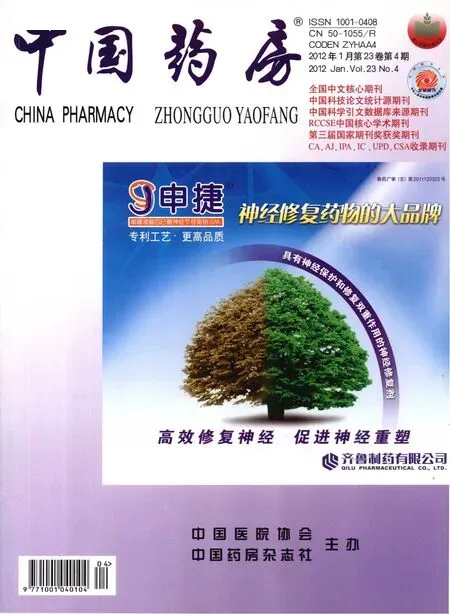普萘洛爾治療嬰幼兒血管瘤的研究進展Δ
肖寒露,陳軍,李俊,楊濤,方蕓(1.南京中醫藥大學藥學院,南京10046;.南京醫科大學附屬南京婦幼保健院,南京 10004;.南京大學醫學院附屬鼓樓醫院,南京 10008)
嬰幼兒血管瘤(Infantile hemangiomas,IH)為最常見的兒童良性腫瘤,白種人新生嬰兒的總體發病率為1.1%~2.6%,1周歲時的發病率更高達10%~12%[1]。IH的發病存在明顯的種族及性別差異(在白種人中的發病率較黃種人與黑種人高,男女性別患病比例為1∶3~1∶5),且其在低出生體重兒和早產兒中的發病率可能更高[2,3]。IH對患兒生理及心理的潛在危害不容忽視,尤其是特殊部位、特殊類型的IH,必須在其增殖期采取積極的干預治療。盡管IH的治療方法眾多,但均存在自身的局限或不足。自從法國醫師Leaute-Labreze C等[4]于2008年在《新英格蘭醫學雜志》上首次報道普萘洛爾用于IH的治療后,該領域立即引起了廣泛的研究熱情[5~9]。本文就IH的自然病史與發病機制、常規治療手段及其缺陷,以及普萘洛爾治療IH的藥理作用、機制、安全用藥等問題作一綜述。
1 IH的自然病史與發病機制
IH具有獨特的自然病史,其在臨床上主要表現為2個完全不同的階段——增殖期與消退期。IH在患兒出生時可能并不明顯,但在出生后不久進入增殖期,其最初的臨床表現為紅色小斑塊或丘疹,在隨后的6個月至1年時間內瘤體持續增大并逐漸穩定,在組織學上通常表現為血管內皮細胞過度分裂增殖、肥大細胞浸潤及基底膜層增厚。IH于患兒1周歲左右開始進入漫長的消退期,此階段可持續幾年甚至十幾年的時間,臨床表現通常為瘤體生長逐漸停止,體積持續變小,患區皮膚開始皺縮并由鮮紅色轉為暗紅色。與增殖期一樣,消退期的IH也有不同程度的肥大細胞浸潤,且消退完成后仍可能遺留色素沉著、毛細血管擴張、纖維和脂肪組織沉積。
由于體內、外模型的限制,關于IH的發病機制至今尚未完全明確,目前有多種理論(如Placenta Theory、Metastatic Theory、Progenitor Cell Theory、Extrinsic Factor Theory)解釋IH的起源[10]。但是,以上理論單獨運用時都不足以解釋關于IH的所有問題。例如,特殊的自然病史及臨床表現、發病的種族及性別差異等。
免疫組織化學的研究成果可能有助于對IH發病機制的理解。在增殖期的IH內皮細胞中,血管生成的分子標記物如增殖細胞核抗原(PCNA)、Ⅳ型膠原酶(CollagenaseⅣ)、血管內皮生長因子(VEGF)以及堿性成纖維細胞生長因子(bFGF)呈現過度表達[11~16]。相反,VEGF與bFGF在消退期的表達則顯著減少[16~18]。另外,血管生成抑制因子——轉化生長因子β(Transforming growth factor-β)在IH增殖期和消退期的表達始終呈現很低的水平[16];金屬蛋白酶組織抑制劑(TIMP,另一種血管生成抑制因子)則顯示只在IH消退期表達[12]。以上研究結果表明,促血管生成因子與抗血管生成因子表達失衡所導致的對血管生成的調節紊亂,可能在IH的發病中扮演著重要角色[16]。
2 IH的常規治療手段及其缺陷
盡管IH有一個自發的消退過程,但其對患兒及家庭的潛在危害必須引起充分重視,有以下情形出現時,應在其增殖期進行積極的早期干預:(1)由于IH好發于供血豐富的頭面部,當其大面積發作時,存在影響患兒容貌甚至毀容的風險;(2)特殊解剖學部位(眼部、呼吸道)的IH可能造成局部壓迫性梗阻,從而可能導致器官的功能障礙(如弱視甚至雙目失明、呼吸受阻甚至衰竭),嚴重時威脅患兒生命;(3)伴發潰瘍、出血以及其他綜合征(如KMS綜合征與PHACES綜合征等)時,患兒的死亡率甚高。
IH的治療手段眾多,但一般而言,以藥物治療為主。臨床上IH治療方法的選擇與多種因素相關,且主要取決于病變部位、深度(淺表、深部、混合)、范圍及大小、分期、是否造成功能障礙等。目前,一線的治療手段為皮質類固醇激素的全身性給藥、局部給藥及血管瘤內注射;而干擾素α、激光治療與手術治療常作為二線治療手段的備選;其他的治療手段包括環磷酰胺、長春新堿、咪喹莫特等的藥物治療、放射治療等[19~21]。值得注意的是,以上手段運用于IH的治療時,均存在自身的局限性,甚至引發嚴重的不良反應。例如,皮質類固醇激素治療的總體有效率不高,且長期用藥可能導致患兒庫欣綜合征樣外貌變化、生長發育遲緩、胃腸道不良反應、心肌肥大、動脈高血壓、潰瘍創口愈合受阻、免疫抑制等;干擾素α則可引起肝藥酶異常、甲狀腺功能減退、抑郁等消化系統及神經系統的不良反應;長春新堿的神經系統毒性、骨髓抑制及消化道不良反應等,都使其臨床應用受到極大限制。另外,過于強烈的治療方法用于IH治療時,必須持審慎態度,如放射治療可能導致患兒局部組織發育障礙及惡性腫瘤發生率提高。
3 普萘洛爾治療IH的藥理作用及機制
2008年,Leaute-Labreze C等[4]在使用普萘洛爾治療出生后不久的嬰兒心臟病時,意外發現2例嬰兒所患IH顏色變淺、范圍縮小。此后,他們又應用普萘洛爾治療了9例顏面部IH患兒,結果均有明顯療效且未見嚴重不良反應,僅個別出現血壓偏低。該報道立即引發了普萘洛爾治療IH的臨床應用與基礎研究的熱潮。截至2011年,已有關于應用普萘洛爾成功治療顏面部[22]、眼部[23~26]、呼吸道[27~31]、肝臟[32,33]以及其他伴有并發癥、多病變部位、甚至嚴重威脅患兒生命的重癥IH[34~36]的大量報道,并證實了普萘洛爾能改變IH的自然病史、阻滯其增殖、介導并促進IH的早期凋亡。進一步的研究表明,普萘洛爾對處于增殖期與消退期的IH均有顯著療效[37,38]。另外,單獨使用普萘洛爾(而不借助其他任何藥物治療或手術治療等手段)治療IH也已經被證實有確切療效[39,40],從而消除了對IH的治療效果是由其他治療手段所主導的疑慮。諸多學者推薦其取代皮質類固醇激素成為IH的一線治療手段[27,41~44]。中華口腔醫學會口腔頜面外科專業委員會脈管性疾病學組也已確定普萘洛爾為治療血管瘤的一線藥物,并納入《口腔頜面部血管瘤治療指南》[45]。
然而,普萘洛爾治療IH的機制迄今尚未完全明確。目前,比較公認的[4,8,9,46]治療機制認為可能是以下 3 個方面共同作用的結果:(1)抑制一氧化氮(NO)合成與釋放,從而導致瘤體血管收縮,此在臨床上表現為用藥后短時間內瘤體顏色變淺,觸診質地變軟。(2)下調VEGF與bFGF的表達而抑制血管生成,并表現為用藥中期IH的生長阻滯。(3)介導并加速毛細血管內皮細胞凋亡從而導致用藥后期瘤體消退。另外,普萘洛爾抑制間質金屬蛋白酶-9(MMP-9)以及人腦微血管內皮細胞(HBMEC)的表達也可能潛在地抑制了IH的血管生成[8,9]。而拮抗Ⅰ型葡萄糖載體(Glut-1)的受體[7,47]、誘導IH內的間質干細胞分化以及誘導G蛋白偶聯受體基因表達的多態性從而提供內源性的β受體阻滯[5]等,都可能在普萘洛爾治療IH的過程中發揮潛在作用。
4 普萘洛爾治療IH的安全用藥問題
就普萘洛爾治療IH而言,至今尚未形成統一的治療方案,且主要集中在給藥劑量與治療周期的差異。目前,比較公認的治療方案[7,37,48]如下:在詳細了解患兒病史并經體格檢查確認其心肺功能正常之后,以首劑量0.5 mg·kg-1分2~3次口服給藥并密切監測患兒的重要生命體征(如脈搏、心率、血壓等)與血糖水平。若未發現明顯的不良反應,則日劑量以0.5 mg·kg-1的幅度(或倍量)遞增直到產生明顯的治療效果或達到2~3 mg·kg-1的維持劑量(一般不超過2 mg·kg-1,且已有研究證明,1.5~2 mg·kg-1日劑量即可加速IH的消退[46])。治療周期一般要求持續到IH的增殖期結束或者瘤體消退并持續穩定,以防止因過早停藥而導致病情復發[28,37,44]。另外,為預防普萘洛爾停藥后的反跳作用,一般要求采用2周以上的時間跨度緩慢減少劑量直至停用。
以上治療方案應用于IH的臨床治療,已被廣泛證明有顯著療效,且鮮有嚴重不良反應的報道。盡管如此,對普萘洛爾用藥可能存在的心動過緩、低血壓、低血糖等嚴重不良反應,亦不可掉以輕心[48,49]。一般而言,IH患兒采取普萘洛爾治療時應已基本形成正常的食物攝取,且在治療初期應頻繁喂食,并加強對重要生命體征與血糖水平的監測力度,以盡量避免以上嚴重不良反應的發生。尤其值得注意的是,普萘洛爾用藥的不良反應對于中國人來說可能有更高的發生率,因為華人對普萘洛爾的耐受能力較差,敏感性高。已有文獻[50]證明,華人對β受體阻滯藥的敏感性較白種人至少高2倍,在使用普萘洛爾治療IH時,有必要適當地降低給藥劑量。正因此,國內治療IH的日劑量多在1~1.5 mg·kg-1,且已被證明安全有效[51,52]。
5 問題與展望
普萘洛爾作為一種非選擇性的β受體阻滯藥,現已被廣泛證實具有治療IH的確切效果,且已有研究證明[44],普萘洛爾治療IH時可能存在劑量-療效的相關性。但鑒于普萘洛爾用藥有導致嚴重不良反應的可能,盲目加大給藥劑量往往會伴隨更大的風險。顯然,普萘洛爾的不良反應在很大程度上與給藥途徑有關,且口服給藥已被證明生物利用度低,存在顯著的首關效應,故真正到達患處并發揮療效的藥量有限。若能將普萘洛爾透皮給藥并直接作用于IH患處,在保證療效的同時,可以有效減免不良反應的發生,并且給藥更加方便,劑量尚可提高。另外,目前已有文獻[53~56]報道其他種類的β受體阻滯藥(如醋丁洛爾與噻嗎洛爾)用于IH的臨床治療同樣有顯著效果,且安全性可能更佳。故有必要開展深入研究以尋求最佳的β受體阻滯藥用于IH的臨床治療,并積極的探索理想的治療方案,以為攻克IH提供有力支持。
[1]Bruckner AL,Freiden,IJ.Hemangiomas of infancy[J].J Am Acad Dermato,2003,48(4):477.
[2]Haggstrom AN,Drolet BA,Baselga E,et al.Prospective study of infantile hemangiomas:demographic,prenatal,and perinatal characteristics[J].J Pediatr,2007,150(3):291.
[3]Drolet BA,Swanson EA,Frieden IJ.Infantile hemangiomas:an emerging health issue linked to an increased rate of low birth weight infants[J].J Pediatr,2008,153(5):712.
[4]Leaute-Labreze C,Dumas de la Roque E,Hubiche T,et al.Propranolol for severe hemangiomas of infancy[J].N Eng J Med,2008,358(24):2 649.
[5]Buckmiller LM.Propranolol treatment for infantile hemangiomas[J].Curr Opin Otolaryngol Head Neck Surg,2009,17(6):458.
[6]Frieden IJ,Drolet BA.Propranolol for infantile hemangiomas:promise,peril,pathogenesis[J].Pediatr Dermatol,2009,26(5):642.
[7]Lawley LP,Siegfried E,Todd JL.Propranolol treatment for hemangioma of infancy:risks and recommendations[J].Pediatr Dermatol,2009,26(5):610.
[8]Zimmermann AP,Wiegand S,Werner JA,et al.Propranolol therapy for infantile haemangiomas:review of the literature[J].Int J Pediatr Otorhinolaryngol,2010,74(4):338.
[9]Storch CH,Hoeger PH.Propranolol for infantile haemangiomas:insights into the molecular mechanisms of action[J].Br J Dermatol,2010,163(2):269.
[10]Lo K,Mihm M,Fay A.Current theories on the pathogenesis of infantile hemangioma[J].Semin Ophthalmol,2009,24(3):172.
[11]Berard M,Sordello S,Ortega N,et al.Vascular endothelial growth factor confers a growth advantage in vitro and in vivo to stromal cells cultured from neonatal hemangiomas[J].Am J Pathol,1997,150(4):1 315.
[12]Takahashi K,Mulliken JB,Kozakewich HP,et al.Cellular markers that distinguish the phases of hemangioma during infancy and childhood[J].J Clin Invest,1994,93(6):2 357.
[13]Giatromanolaki A,Arvantidou V,Hatzmichael A,et al.The HIF-2a/VEGF pathway activation in cutaneous capillary haemangioms[J].Pathology,2005,37(2):149.
[14]Kleinman ME,Greives MR,Churgin SS,et al.Hypoxia-induced mediators of stem/progenitor cell trafficking are increased in children with haemangioma[J].Arterioscler Thromb Vasc Biol,2007,27(12):2 664.
[15]Qu Z,Liebler JM,Powers MR,et al.Mast cells are a major source of basic fibroblast growth factor in chronic inflammation and cutaneous hemangioma[J].Am J Pathol,1995,147(3):564.
[16]Chang J,Most D,Bresnick S,et al.Proliferative haemangiomas:analysis of cytokine gene expression and angiogenesis[J].Plast Reconstr Surg,1999,103(1):1.
[17]Przewratil P,Sitkiewicz A,Wyka K,et al.Serum levels of vascular endothelial growth factor and basic fibroblast growth factor in children with hemangiomas and vascular malformations——preliminary report[J].Pediatr Dermatol,2009,26(4):399.
[18]Przewratil P,Sitkiewicz A,Andrzeijwska E.Local serum levels of vascular endothelial growth factor in infantile hemangioma:intriguing mechanisms of endothelial growth[J].Cytokine,2010,49(2):141.
[19]Schwartz RA,Sidor MI,Musumeci ML,et al.Infantile haemangiomas:a challenge in paediatric dermatology[J].J Eur Acad Dermatol Venereol,2010,24(6):631.
[20]Akhavan A,Zippin JH.Current treatments for infantile hemangiomas[J].J Drugs Dermatol,2010,9(2):176.
[21]Nguyen J,Fay A.Pharmacologic therapy for periocular infantile hemangiomas:a review of the literature[J].Semin Ophthalmol,2009,24(3):178.
[22]Bonifazi E,Colonna V,Mazzotta F,et al.Propranolol in rapidly growing hemangiomas[J].Eur J Pediatr Dermatol,2008,18(3):185.
[23]Haider KM,Plager DA,Neely DE,et al.Outpatient treatment of periocular infantile hemangiomas with oral propranolol[J].J AAPOS,2010,14(3):251.
[24]Fay A,Nguyen J,Jakobiec FA,et al.Propranolol for isolated orbital infantile hemangioma[J].Arch Ophthalmol,2010,128(2):256.
[25]Cheng JF,Gole GA,Sullivan TJ.Propranolol in the management of periorbital infantile haemangioma[J].Clin Exp Ophthalmol,2010,38(6):547.
[26]Li YC,McCahon E,Rowe NA,et al.Successful treatment of infantile haemangiomas of the orbit with propranolol[J].Clin Exp Ophthalmol,2010,38(6):554.
[27]Denoyelle F,Leboulanger N,Enjolras O,et al.Role of propranolol in the therapeutic strategy of infantile laryngotracheal hemangioma[J].Int J Pediatr Otorhinolaryngol,2009,73(8):1 168.
[28]Buckmiller L,Dyamenahalli U,Richter GT.Propranolol for airway hemangiomas:case report of novel treatment[J].Laryngoscope,2009,119(10):2 051.
[29]Rosbe KW,Suh KY,Meyer AK,et al.Propranolol in the management of airway infantile hemangiomas[J].Arch Otolaryngol Head Neck Surg,2010,136(7):658.
[30]Leboulanger N,Fayoux P,Teissier N,et al.Propranolol in the therapeutic strategy of infantile laryngotracheal hemangioma:A preliminary retrospective study of French experience[J].Int J Pediatr Otorhinolaryngol,2010,74(11):1 254.
[31]Cohen-Cymberknoh M,Avital A,Shoseyov D,et al.Propranolol in the treatment of subglottic hemangioma[J].Paediatr Respir Rev,2010,11(1):S93.
[32]Marsciani A,Pericoli R,Alaggio R,et al.Massive response of severe infantile hepatic hemangioma to propanolol[J].Pediatr Blood Cancer,2010,54(1):176.
[33]Mazereeuw-Hautier J,Hoeger PH,Benlahrech S,et al.Efficacy of propranolol in hepatic infantile hemangiomas with diffuse neonatal hemangiomatosis[J].J Pediatr,2010,157(2):340.
[34]Theletsane T,Redfern A,Raynham O,et al.Life-threatening infantile haemangioma:a dramatic response to propranolol[J].J Eur Acad Dermatol Venereol,2009,23(12):1 465.
[35]Manunza F,Syed S,Laguda B,et al.Propranolol for complicated infantile haemangiomas:a case series of 30 infants[J].Br J Dermatol,2010,162(2):466.
[36]Truong MT,Chang KW,Berk DR,et al.Propranolol for the treatment of a life-threatening subglottic and mediastinal infantile hemangioma[J].J Pediatr,2010,156(2):335.
[37]Sans V,Dumas de la Roque E,Berge J,et al.Propranolol for severe infantile hemangiomas:follow-up report[J].Pediatrics,2009,124(3):e423.
[38]Buckmiller LM,Munson PD,Dyamenahalli U,et al.Propranolol for infantile hemangiomas:Early experience at a tertiary vascular anomalies center[J].Laryngoscope,2010,120(4):676.
[39]Maturo S,Hartnick C.Initial experience using propranolol as the sole treatment for infantile airway hemangiomas[J].Int J Pediatr Otorhinolaryngol,2010,74(3):323.
[40]Jephson CG,Manunza F,Syed S,et al.Successful treatment of isolated subglottic haemangioma with propranolol alone[J].Int J Pediatr Otorhinolaryngol,2009,73(12):1 821.
[41]Denoyelle F,Garabedian EN.Propranolol may become first-line treatment in obstructive subglottic infantile hemangiomas[J].Otolaryngol Head Neck Surg,2010,142(3):463.
[42]Holmes WJ,Mishra A,Gorst C,et al.Propranolol as first-line treatment for infantile hemangiomas[J].Plast Re-constr Surg,2010,125(1):420.
[43]Mishra A,Holmes WJ,Gorst C,et al.Role of propranolol in the management of periocular hemangiomas[J].Plast Reconstr Surg,2010,126(2):671.
[44]Holmes WJM,Mishra A,Gorst C,et al.Propranolol as first-line treatment for rapidly proliferating infantile haemangiomas[J].J Plast Reconstr Aesthet Surg,2011,64(4):445.
[45]鄭家偉,周 琴,王延安,等.口腔頜面部血管瘤治療指南[J].中國口腔頜面外科雜志,2011,9(1):61.
[46]Tan ST,Itinteang T,Leadbitter P.Low-dose propranolol for infantile haemangioma[J].J Plast Reconstr Aesthet Surg,2011,64(3):292.
[47]Cruz OA,Siegfried EC.Propranolol treatment for periocular capillary hemangiomas[J].J AAPOS,2010,14(3):199.
[48]Siegfried EC,Keenan WJ,Al-Jureidini S.More on propranolol for hemangiomas of infancy[J].N Engl J Med,2008,359(26):2 846.
[49]Holland KE,Frieden IJ,Frommelt PC,et al.Hypoglycemia in children taking propranolol for the treatment of infantile hemangioma[J].Arch Dermatol,2010,146(7):775.
[50]Zhou HH,Koshakji RP,Silberstein DJ,et al.Racial difference in drug response:altered sensitivity to and clearance of propranolol in men of Chinese descent as compared with American whites[J].N Engl J Med,1989,320(9):565.
[51]秦中平,劉學鍵,李克雷,等.小劑量普萘洛爾口服治療嬰兒血管瘤的近期療效與安全性評價[J].中華醫學雜志,2009,89(44):3 130.
[52]劉學鍵,秦中平,邰茂眾,等.普萘洛爾治療嬰幼兒腮腺血管瘤的臨床觀察[J].中華口腔醫學雜志,2010,45(5):292.
[53]Bigorre M,Van Kien AK,Valette H.Beta-blocking agent for treatment of infantile hemangioma[J].Plast Reconstr Surg,2009,123(6):195e.
[54]Blanchet C,Nicollas R,Bigorre M,et al.Management of infantile subglottic hemangioma:acebutolol or propranolol[J].Int J Pediatr Otorhinolaryngol,2010,74(8):959.
[55]Guo S,Ni N.Topical treatment for capillary hemangioma of the eyelid using beta-blocker solution[J].Arch Ophthalmol,2010,128(2):255.
[56]Pope E,Chakkittakandiyil A.Topical timolol gel for infantile hemangiomas:a pilot study[J].Arch Dermatol,2010,146(5):564.

